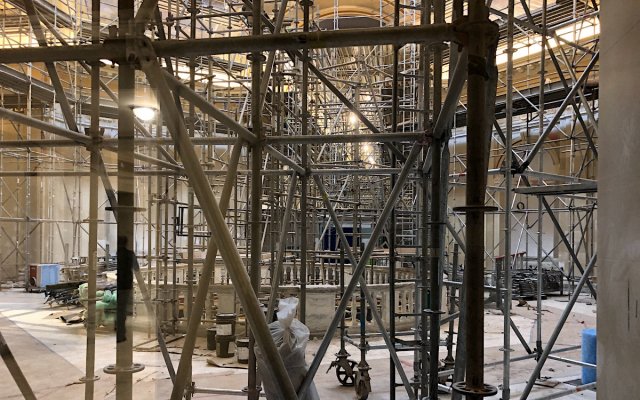
What happens when a wall is built between two partners? A lot can change: dynamics, communication, atmosphere and perception.
At the Oklahoma State Capitol for the 2020 legislative session, literal walls have been constructed between the House and Senate, and the building’s most valuable gathering space — its fourth-floor rotunda — has been closed for a face lift.
Over the 2020 session’s first three weeks, the impact of that impediment has not been fully clear, but the situation has been noticed by lawmakers, lobbyists, media and the public: This session feels strange.
A performance without its most welcoming stage
Perhaps this year’s extended focus on guns and abortion has run longer than expected, or perhaps the impending 2020 election cycle has put red meat on the metaphorical menu in a way the building mostly avoided during 2018’s budget battle. As far as real menus go, the ground floor’s Health Nut Cafe is now serving up burgers, so Capitol visitors begging for beef have another option.
But in 2020, one option unavailable at the Capitol is to gather in its fourth-floor rotunda, be it for small talk, annual events, public rallies or the complicated work done through chance encounters of face-to-face communication. This year’s performance of Oklahoma’s annual legislative spectacle — so steeped in political theater — lacks its traditional theater in the round, a functional change in the building, business and relationship dynamics among lawmakers, lobbyists, media and the public.
As a result, conversations are tucked into corners of hallways. Finding people is harder, as the House and Senate lobbies are not visible to one another. Phones seem more important than ever, and seats are sought like hot commodities. With one elevator closed and the rest busy, working the building requires more stairs than ever, and moving between the House and Senate involves running a square NASCAR track.
Political theater: The bears are getting restless
How are negotiations going now that the Legislature has its certified revenue picture — $85.5 million less than last year — from the Board of Equalization? It’s hard (and too early) to tell.
In recent years, seeing appropriations committee chairpersons, Senate President Pro Tempore Greg Treat (R-OKC) or House Majority Floor Leader Jon Echols (R-OKC) walk with determination across the fourth-floor rotunda signaled to onlookers that something might be happening between chambers; something was physically moving. Watching legislative leaders or a governor cross the rotunda has been a remaining, symbolic scene for Oklahoma’s bicameral body. Long ago, technology removed the literalism of “sending a bill over” to the other side.
In modern times, that has made the State Capitol’s fourth-floor rotunda seem important. A big, bright and welcoming space — A Gathering Place for Oklahoma — the rotunda typically combines friendly feelings with brutal business, all while a rotating cast of public advocates passes out pastries and voices various viewpoints. Block off the middle tent, however, and Oklahoma’s annual circus feels more like a crowded peep show. Not even the TV news crews have a good backdrop for hyping acts, and the bears are getting restless, despite their renovated cages.
Anticipating beautiful results
The good news is that the first and fourth-floor rotundas of the Oklahoma State Capitol are scheduled to be open again in 2021, and admirable work to restore the state’s top historical structure is rounding the bend and heading for home. Completed areas look terrific, and it’s easy to forget that the building’s permanent walls will eventually come back to life with art and artifacts of state history. Construction crews — who mostly keep their heads down to avoid the smell of politics — have worked diligently for years and largely go unthanked by those who will enjoy the fruits of their labor for decades.
When they do re-open, the Capitol’s rotundas will be as marvelous and welcoming as ever. They will once again be filled by people reminding Oklahoma whose house they are in. Those who office in the building on a daily basis (at least during session) will rejoice at the return of open, friendly spaces.
Until then, however, lawmakers and the rest of the Capitol chattering class must work around — and walk around — literal walls that temporarily separate the two halves of Oklahoma’s Legislature. May their spirits stay high and their cell phones remain charged.





















